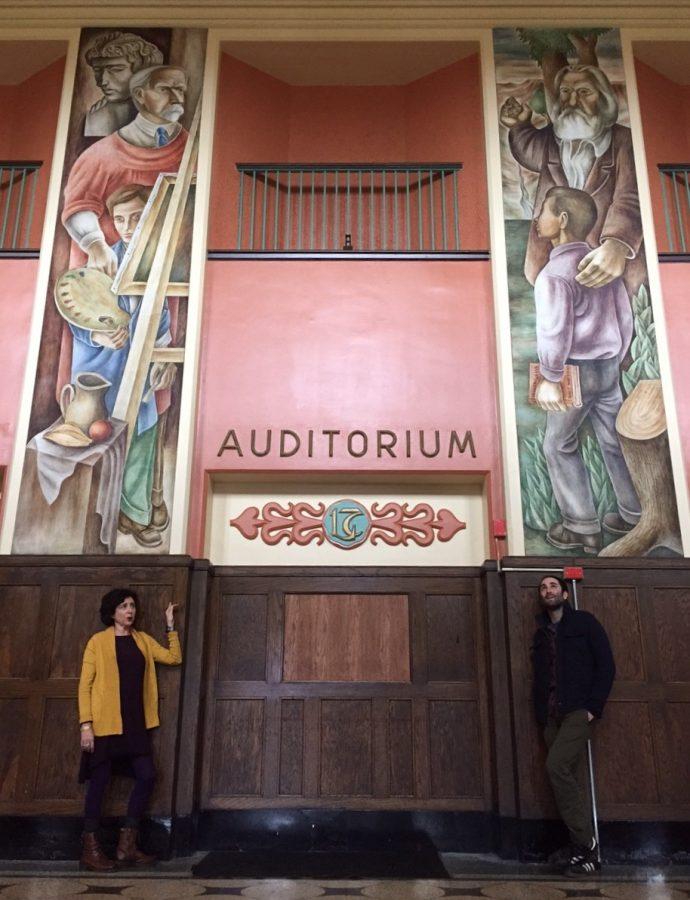The man behind the murals
Rachel and Michael Siporin discuss “Homage to the Arts” by Mitchell Siporin.
Rachel Siporin, an art professor at Central Connecticut State University, retold the life of Mitchell Siporin, her father, as though it was committed to memory. Yet, when she walked into Lane’s auditorium foyer as part of the Art Docent program, it would be one of the first times she would see her father’s work in the Midwest.
Alongside her son, Michael, an art teacher at Knox College, Siporin traveled across the Midwest to view her father’s artworks. One of stops was Lane, where they viewed Siporin’s mural “Homage to the Arts.”
As she learned more about the art her father created, she began to reveal the life that her father had built through his murals.
In an interview with Ms. Katherine Nester, head of the Art Docent program at Lane, Rachel Siporin said that before entering high school, Mitchell Siporin rarely drew. He had never taken any art classes, and did not view himself as an artist. Yet, this was the man behind the murals in Lane’s auditorium.
Siporin was born in Chicago to Russian and Polish immigrants in 1910. For the first six years of his life, he only spoke Yiddish.
Rachel Siporin said that her father unexpectedly revealed his affinity for art in a botany class. After drawing botany illustrations, his classmates began to refer to him as “Mitchell Siporin, the artist.” With the support of his classmates, Siporin began to view himself as an artist.
Politically, Siporin was left-leaning, and it showed through his work. His work often portrayed labor history, specifically the struggles of the working class man.
When he completed a series of drawings at age 24, Siporin heavily researched the Haymarket incident, a Chicago labor protest in 1886, to incorporate into his work.
“I think the research that he did for the Haymarket drawings prepared him well for working in the WPA,” Rachel Siporin said.
The Works Progress Administration (WPA), one of President Franklin D. Roosevelt’s New Deal programs, functioned as a work-relief program and employed more than 8.5 million people. The employees were paid to build bridges, roads, public buildings, parks and airports.
Siporin was an artist under the WPA. He created frescos and murals for the public buildings that had been built under the organization.
The fresco located in the auditorium foyer of Lane was one of Siporin’s first works for the WPA.
The mural, titled “Homage to the Arts,” was completed in 1938. Each panel represents the relationship between teacher and student. Theatre, art, literature, and music are each separately portrayed in each panel.
“There’s always, in my father’s work, a tenderness,” Siporin said. “A relationship of the figures is shown.”
According to his daughter, Siporin’s pieces showcased his expertise. Working with fresco, as Siporin did, required an immense amount of technique. Fresco paintings involve pigment painted onto wet plaster.
Siporin, who did not study art in school, was self-taught. When he attended the Art Institute, he would encounter a fellow student whom he described as “able to paint a wet fish.” Despite his peer’s technical skill, Siporin did not think that the student would have an interesting career.
“My father really believed that more important than technical knowledge, was your point of view and what you wanted to say in your work.” Siporin said.
Through Siporin’s fresco paintings, his artistic technique was evident. According to Siporin, each of her father’s frescoes showcased his fantastic drawing and his technique with the fresco medium.
Another fresco that is part of the series in Lane’s auditorium, is one of a boy accompanied by the poet Walt Whitman.
“When you look at the figure of the boy in the painting, you get the feeling that he [Siporin] is taking from his own experience and that there is tenderness,” Siporin said. “You see the very expressive figures. You see the relationship of the two figures, again being very tender, and that was a quality that existed in his work.”
Aside from his fresco work at Lane, under the WPA, Siporin would later go on to create murals in post offices. During this time, he met Edward Millman.
Both Siporin and Millman would be relocated to St. Louis, where they worked on a $29,000 commission. According to an article by Charles Swaney on the New Deal, the project was “the largest single project awarded for a Post Office by the Treasury Section.”
Siporin said that her father depicted the Native Americans in the St. Louis mural as grand in stature, emphasizing their importance. This political message, according to Siporin, contrasted with the idea that “European explorers were the ones who saved the day for the United States Development.”
After completing the St. Louis commission, Siporin enlisted in the U.S. Army with hopes of becoming a war artist. Siporin would be situated in Italy, and then North Africa, where he would take pictures of war scenes, and portraits of soldiers.
Siporin later taught at Brandeis University, after creating their art department, from 1951, until his death in 1976. Throughout this time, he continued to paint and exhibit his work.
Mitchell Siporin was a man who spent his life doing what he loved. He will continue to be remembered through his fresco and figurative art pieces. His fresco work in Lane’s auditorium foyer is just one example of his lasting legacy.
Before finishing her interview, Siporin made it known that “she has always been proud of her father.”
Your donations directly fund the Lane Tech student journalism program—covering essential costs like website hosting and technology not supported by our school or district. Your generosity empowers our student reporters to investigate, write, and publish impactful stories that matter to our school community.
This website is more than a publishing platform—it's an archive, a research tool, and a source of truth. Every dollar helps us preserve and grow this resource so future students can learn from and build on the work being done today.
Thank you for supporting the next generation of journalists at Lane Tech College Prep!

Brianna is Vietnamese, and was born and raised in Chicago. Her favorite past time activity is napping and eating. When she’s not doing either, she likes...






